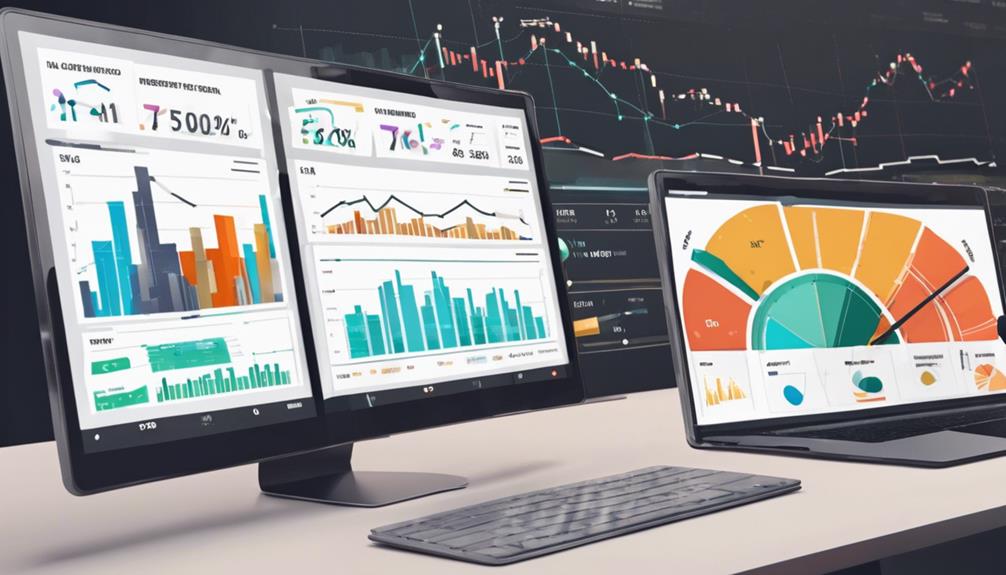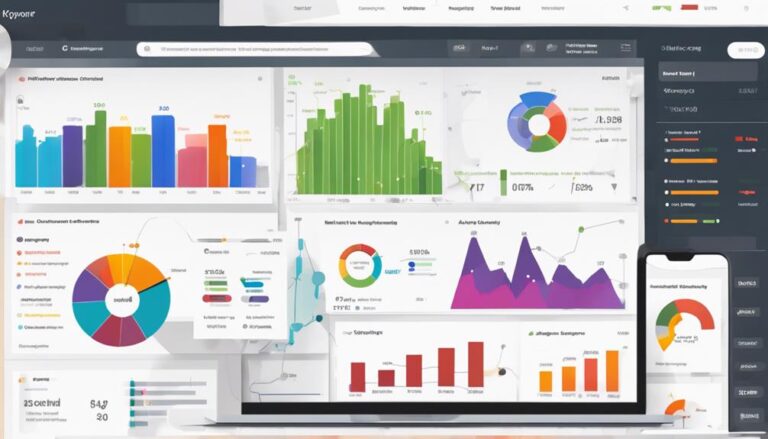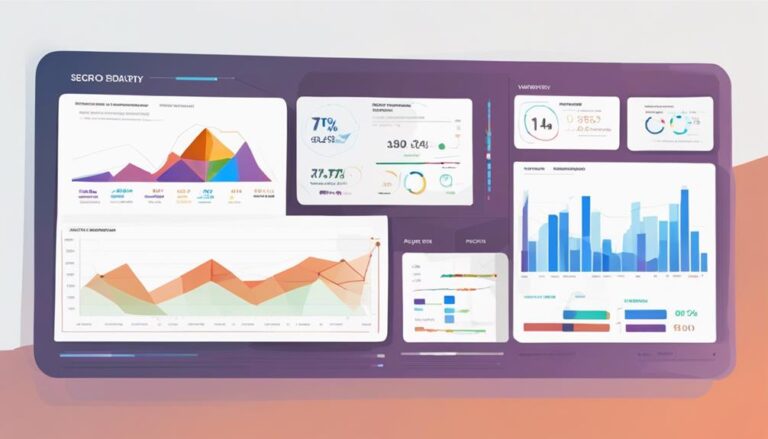
You've invested time and resources into optimizing your website for search engines, but how can you truly measure the success of your SEO efforts?
While tracking metrics like organic traffic and keyword rankings is essential, there's more to the equation.
Understanding the nuances of user behavior, the impact of backlinks, and the intricacies of conversion rates can provide a comprehensive view of your SEO performance.
So, how do these factors intertwine to paint a clear picture of your website's search engine visibility and effectiveness?
Key Takeaways
- Analyze organic traffic trends to measure SEO success accurately.
- Optimize keywords based on performance data for improved results.
- Enhance SERP visibility through strategic keyword research and structured data.
- Monitor CTR, bounce rates, and backlinks for a comprehensive SEO assessment.
Organic Traffic Analysis
To effectively measure SEO success, it's essential to conduct a thorough analysis of organic traffic to understand the performance of your website. Organic traffic, which represents visits from search engines, is a key metric in evaluating SEO effectiveness. By utilizing tools like Google Search Console, you can track organic traffic, keyword rankings, and overall website performance accurately.
Analyzing organic traffic provides valuable insights into how well your site is performing in search engine results. It allows you to monitor improvements over time, identify trends, and adapt optimization strategies accordingly. Benchmarking your organic traffic against that of your competitors can also offer essential perspective on where you stand in the market.
Moreover, studying user behavior through organic traffic analysis helps pinpoint areas for enhancement. Understanding how users interact with your site, which keywords drive the most traffic, and where visitors are coming from can guide strategic decisions to boost organic traffic growth effectively.
Keyword Performance Evaluation
Analyzing keyword performance is crucial for gauging the effectiveness of your SEO efforts. This involves tracking rankings and identifying high-performing keywords that drive traffic and conversions. To evaluate your keyword performance effectively, follow these steps:
- Track Rankings: Keep an eye on where your keywords stand on SERPs to understand how they're performing compared to your competitors.
- Monitor Organic Traffic: Look at changes in keyword rankings and their impact on organic traffic to assess the effectiveness of your SEO strategies.
- Utilize Google Search Console: Use tools like Google Search Console to delve into performance data, identify trends, and uncover opportunities for improvement.
- Optimize Keyword Strategies: Identify high-performing keywords that are driving conversions and adjust your keyword strategies based on performance data to enhance your SEO success.
SERP Visibility Assessment
How can you assess the visibility of your website in search engine results pages for specific keywords effectively?
SERP visibility assessment is crucial in understanding how frequently your website appears in search engine results, considering both keyword rankings and SERP features. Tools such as Position Tracking can aid in monitoring and enhancing your website's visibility over time.
To improve visibility, focus on comprehensive keyword research, implementing structured data, and following SEO best practices.
By enhancing your SERP visibility, you can expect an increase in organic traffic, ultimately driving more potential customers to your website.
Monitoring and improving your website's presence in search engine results pages is fundamental to achieving SEO success. Stay proactive in optimizing your visibility to increase your website's chances of being seen by your target audience.
Click-Through Rate Analysis
Assessing and optimizing your Click-Through Rate (CTR) is crucial for maximizing the impact of your website's search snippets and driving organic traffic effectively. To enhance your understanding and strategic approach to CTR analysis, consider the following key points:
- CTR Definition: CTR represents the percentage of users who click on your website from search engine results pages (SERP).
- Calculation Method: Calculate CTR by dividing the number of clicks your webpage receives by the number of impressions it gets.
- Impact on Traffic: Monitoring and improving CTR can significantly boost website traffic by enhancing the effectiveness of title tags and meta descriptions.
- SEO Performance: CTR serves as a vital metric to evaluate the relevance and appeal of your website's search snippets, and increasing CTR through strategic optimization can result in higher organic traffic and improved overall SEO performance.
Bounce Rate Monitoring
Monitoring your website's bounce rate is essential for evaluating user engagement and identifying potential areas for improvement in SEO and content strategy. Bounce rate, which represents the percentage of users who leave a website without interacting with any elements, is a crucial metric in understanding user experience. High bounce rates often signal poor user engagement, irrelevant content, or misleading titles.
By monitoring and analyzing bounce rates, you can pinpoint specific pages or sections of your website that may need optimization. Lowering bounce rates can lead to increased user engagement, longer session durations, and ultimately improved search rankings. Additionally, analyzing bounce rates across different pages provides valuable insights into the effectiveness of landing pages and content relevance.
This data-driven approach allows you to make informed decisions to enhance your website's performance, user experience, and overall SEO success.
Backlink Tracking
To optimize your SEO performance, monitoring backlinks is key. Assessing link quality and analyzing competitors' backlink profiles are essential strategies.
Link Quality Assessment
Ensuring that your backlinks are authoritative, trustworthy, and relevant is paramount for achieving SEO success. Here are key steps to assess the quality of your backlinks effectively:
- Use Tools: Leverage platforms like Ahrefs and SEMRush for in-depth backlink analysis.
- Create High-Quality Backlinks: Focus on attracting backlinks through informative content and strategic partnerships.
- Benchmark Against Competitors: Compare your backlink profile with competitors to gauge quality and identify areas for improvement.
- Prioritize Value and Credibility: Build backlinks that not only increase your website's authority but also provide value to users, enhancing your SEO efforts.
Competitor Backlink Analysis
Analyzing competitor backlink profiles provides valuable insights into their linking strategies and reveals potential opportunities for enhancing your own SEO performance. By tracking the number of backlinks pointing to competitor websites, you can gauge their authority and ranking potential. Utilize tools like Ahrefs, SEMRush, or Moz to compare backlink profiles with competitors and identify gaps. Assessing the quality and relevance of competitor backlinks is crucial to understanding the effectiveness of their link building efforts. Implement a proactive backlink tracking strategy to stay ahead of competitors and improve your own backlink profile.
| Backlink Analysis Tools | Features | Benefits |
|---|---|---|
| Ahrefs | Backlink analysis, competitor research | Comprehensive insights |
| SEMRush | Backlink audit, link building opportunities | Competitive advantage |
| Moz | Backlink metrics, domain authority | Strategic decision-making |
Conclusion
In conclusion, measuring SEO success requires a comprehensive approach that includes analyzing:
- Organic traffic
- Keyword performance
- SERP visibility
- Click-through rates
- Bounce rates
- Backlinks
One interesting statistic to consider is that websites ranking on the first page of Google search results receive 95% of all web traffic.
By continuously monitoring and optimizing these key metrics, you can effectively track the impact of your SEO strategies and drive tangible results for your website.
- How to Plan a Content Calendar That Works - 29/10/2025
- SEO Content vs. Social Media Content: What’s the Difference? - 23/10/2025
- The Best Types of Content for Service Businesses - 16/10/2025


